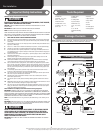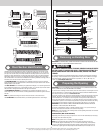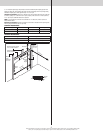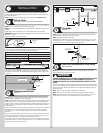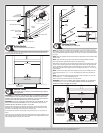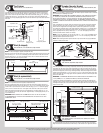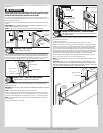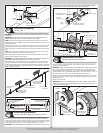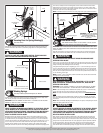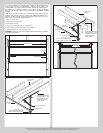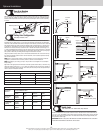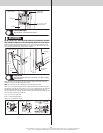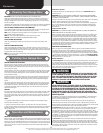
Please Do Not Return This Product To The Store. Contact your local Wayne-Dalton dealer. To find your local Wayne-Dalton dealer,
refer to your local yellow pages business listings or go to the Find a Dealer section online at www.Wayne-Dalton.com
Left cable
drum
Counterbalance
lift cable
Locking pliers
Set
screws
Jamb
Left end
bearing
bracket
Torsion
shaft
Securing Door for Spring Winding(s)
Tools: Vice Clamps
20
With the door in the fully closed position, place vice clamps onto both vertical tracks just
above the third track roller. This is to prevent the garage door from rising while winding
springs.
WARNING WARNING
FAILURE TO PLACE VICE CLAMPS ONTO VERTICAL TRACK CAN ALLOW
DOOR TO RAISE AND CAUSE SEVERE OR FATAL INJURY.
Vice clamps above third
track roller on both sides of
door
Bottom section
Vice clamps attached to inner
and outer rail of vertical track
Winding Springs
Tools: Step Ladder, Approved winding bars, 3/8” Wrench
21
Position a ladder slightly to the side of the spring so that the winding cone is easily acces-
sible, and so your body is not directly in line with the winding bars.
IMPORTANT: CHECK THE WARNING TAG ATTACHED TO THE SPRING FOR THE REQUIRED
NUMBER OF COMPLETE TURNS, TO BALANCE YOUR DOOR.
WARNING WARNING
PRIOR TO WINDING OR MAKING ADJUSTMENTS TO THE SPRINGS, ENSURE
YOU’RE WINDING IN THE PROPER DIRECTION AS STATED IN THE INSTAL-
LATION INSTRUCTIONS. OTHERWISE THE SPRING FITTINGS MAY RELEASE
FROM SPRING IF NOT WOUND IN THE PROPER DIRECTION AND COULD
RESULT IN SEVERE OR FATAL INJURY.
Alternately inserting the winding rods into the holes of the springs winding cone, rotate
the winding cone upward toward the ceiling, 1/4 turn at a time, until the required number
of complete turns for your door height is achieved. As the last 1/8 to 1/4 turn is achieved,
securely hold the winding rod while tightening both set screws in the winding cone to 14-15
ft. lbs. of torque (once set screws contact the torsion shaft, tighten screws one full turn).
Carefully remove winding rod from winding cone. Repeat for the opposite spring. While
holding the door down to prevent it from raising unexpectedly in the event the spring(s) were
over-wound, carefully remove the locking pliers from the torsion shaft and vertical tracks.
Adjustments to the number of turns stated may be necessary. If door rises off floor under
spring tension alone, reduce spring tension until door rests on the floor. If the door is hard to
rise or drifts down on its own, add spring tension.
NOTE: An unbalanced door such as this can cause garage door opener operation problems.
HIGH SPRING TENSION CAN CAUSE
SERIOUS INJURY OR DEATH.
DO NOT adjust, repair or remove springs or parts to
which springs are connected, such as steel brack-
ets, cables, wood blocks, fasteners or other parts of
the counterbalance system.
Adjustments or repairs must ONLY be made by a
trained door systems technician using proper tools
and instructions.
DO NOT remove, cover or paint over this tag.
Prod-
uct user should inspect this tag periodically for
legibility and should order a replacement tag from
the door manufacturer, as needed.
©Copyright 2010 Overhead Door Corporation
102081 REV2 06/24/2010
Torsion shaft
Winding
cone
Torsion
spring(s)
Approved
winding rod
Set
screws
IMPORTANT: CHECK THE WARNING
TAG ATTACHED TO THE SPRING FOR
THE REQUIRED NUMBER OF
COMPLETE TURNS, TO BALANCE
YOUR DOOR.
Warning
tag
Approved winding rod
Rear Back Hangs
Tools: Ratchet wrench, Socket: 1/2” 5/8”, Wrench: 1/2” 5/8”, (2) Vice
clamps, Tape measure, Level, Hammer, Step Ladder
22
IMPORTANT: HOLD THE DOOR DOWN TO PREVENT IT FROM RISING UNEXPECTEDLY IN THE
EVENT THE SPRING(S) WAS OVER-WOUND AND CAUTIOUSLY REMOVE VICE CLAMPS FROM
VERTICAL TRACKS.
Raise the door until the top section and half of the next section are in the horizontal track
radius. Do not raise door any further since rear of horizontal tracks are not yet supported.
WARNING WARNING
RAISING DOOR FURTHER CAN RESULT IN DOOR FALLING AND CAUSE
SEVERE OR FATAL INJURY.
Clamp a pair of vice clamps onto the vertical tracks just above the second track roller on one
side, and just below the second track roller on the other side. This will prevent the door from
raising or lowering while installing the rear back hangs.
Using perforated angle (may not be supplied), (2) 5/16” x 1-5/8” hex head lag screws and
(3) 5/16” bolts with nuts (may not be supplied), fabricate rear back hangs for the horizontal
tracks. Attach the horizontal tracks to the rear back hangs with 5/16”-18 x 1 hex bolts and
nuts (may not be supplied). Horizontal tracks must be level and parallel with door within 3/4”
to 7/8” maximum of door edge.
NOTE: If an idrive
®
opener is installed, position horizontal tracks one hole above level when
securing it to the rear back hangs.
WARNING WARNING
KEEP HORIZONTAL TRACKS PARALLEL AND WITHIN 3/4” TO 7/8” MAXI-
MUM OF DOOR EDGE, OTHERWISE DOOR COULD FALL, RESULTING IN
SEVERE OR FATAL INJURY.
IMPORTANT: DO NOT SUPPORT THE WEIGHT OF THE DOOR ON ANY PART OF THE REAR
BACK HANGS THAT CANTILEVERS 4” OR MORE BEYOND A SOUND FRAMING MEMBER.
NOTE: If rear back hangs are to be installed over drywall, use (2) 5/16” x 2” hex head lag
screws and make sure lag screws engage into solid structural lumber.
NOTE: 26” angle must be attached to sound framing members and nails should not be
used.
Now, permanently attach the weatherstrips on both door jambs and header. The weather-
strips were temporarily attached in Preparing the Opening, in the pre-installation section of
this manual.
NOTE: When permanently attaching the weatherstrips to the jambs, avoid pushing the weath-
erstrips too tightly against the face of door.
WARNING WARNING
PRIOR TO WINDING OR MAKING ADJUSTMENTS TO THE SPRINGS, ENSURE
YOU’RE WINDING IN THE PROPER DIRECTION AS STATED IN THE INSTAL-
LATION INSTRUCTIONS. OTHERWISE THE SPRING FITTINGS MAY RELEASE
FROM SPRING IF NOT WOUND IN THE PROPER DIRECTION AND COULD
RESULT IN SEVERE OR FATAL INJURY.
Now, lift door and check its balance. Adjustments to the required number of spring turns
stated may be necessary. If door rises off floor under spring tension alone, reduce spring
tension until door rests on the floor. If the door is hard to raise or drifts down on its own, add
spring tension. A poorly balanced door can cause garage door operator operation problems.
To adjust spring tension, fully close door. Apply vice grips to track above third track roller.
Insert a winding rod into the winding cone. On single spring doors, counterbalance lift
cable tension must be maintained by placing vice grips on torsion shaft before loosening
11



